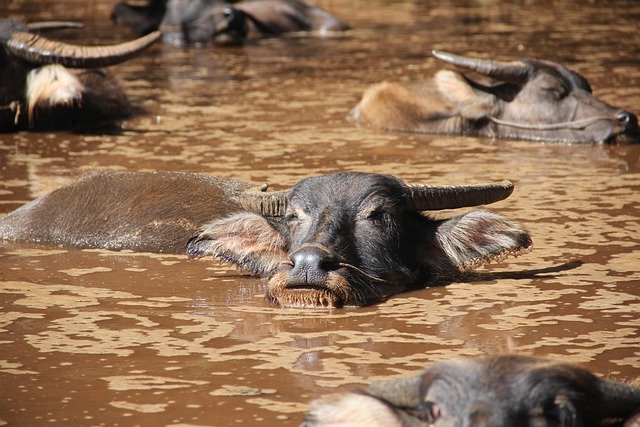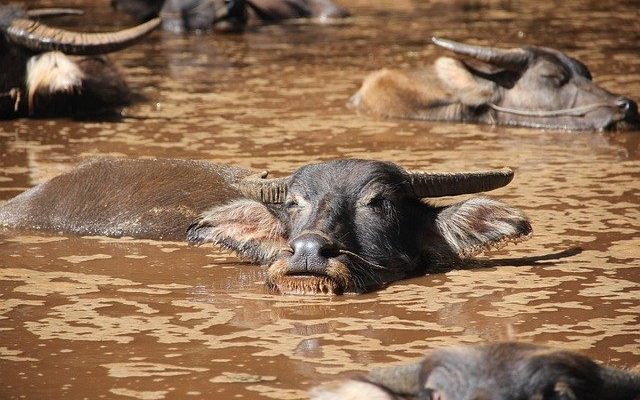
Water buffaloes are often found in areas such as Southeast Asia, where they play a vital role in agriculture. They help with farming while also showing just how well they’ve evolved to thrive in challenging conditions. Let’s dive into the incredible ways water buffaloes not only survive but truly flourish in harsh environments.
Physical Adaptations for Survival
One of the most fascinating aspects of water buffaloes is their physical adaptations. Their thick skin and robust build allow them to endure extreme heat and rough terrains. Think of it like wearing a natural armor; their skin protects them from harsh weather and even irritating insects.
They also have large, flat hooves that act like snowshoes, preventing them from sinking into mud or marshy ground. This is crucial during the monsoon season when many parts of their habitat can turn into a swamp. By moving with ease through such areas, water buffaloes can reach food and water that other animals might find inaccessible.
Additionally, their unique body structure enables them to thrive in hot climates. With a smaller surface area compared to their volume, they lose less heat and can maintain a stable body temperature. This is vital in regions where daytime temperatures can skyrocket. Here’s the thing: their body is like a finely tuned machine, working perfectly in tandem with their environment.
Behavioral Strategies for Finding Food
Food can be hard to come by in harsher climates, but water buffaloes have some clever tricks up their sleeves. They are herbivores, primarily grazing on grasses and aquatic plants, but they adapt their feeding habits based on availability. In the dry season, they seek out areas with more vegetation, often traveling significant distances to find the right patches to graze.
They are also known to dig for roots and tubers during times when grass is scarce. It’s a bit like foraging—by using their strength to uncover hidden food sources, they can sustain themselves even when options seem limited. This adaptability shows their resourcefulness; they aren’t just surviving, they’re thriving!
Furthermore, water buffaloes often graze in groups, which helps them share information about food sources. There’s a sense of community among them, much like friends sharing tips about the best local spots to eat. This behavior not only helps them find food more efficiently, but it also offers protection from predators.
Water Management and Cooling Techniques
Water is life, especially in harsh environments. Water buffaloes have a fascinating relationship with water, not just for drinking but also for cooling off. You might have seen them wallowing in mud. This behavior might look leisurely, but it serves a crucial purpose. The mud creates a protective layer on their skin, shielding them from sunburn and irritating insects.
When they submerge themselves in water, it’s a straightforward yet effective cooling technique. Water buffaloes can’t sweat like humans do, so they rely on this method to regulate their body temperature, keeping themselves cool in the blazing heat. It’s like having a personal air conditioner built into their daily routine!
In addition to wallowing, these animals have a keen sense of where to find water sources. They often journey long distances in search of lakes, rivers, and streams, showcasing their incredible navigational abilities. If there’s one thing we can learn from them, it’s the importance of knowing where to find resources, especially in tough conditions.
Social Structure and Herd Dynamics
The social structure of water buffaloes plays a vital role in their survival. They are social animals that typically live in herds led by a dominant female. This hierarchy helps maintain order and stability within the group, allowing them to better face challenges together.
Being part of a herd provides safety in numbers. When a predator approaches, the herd can work together to scare it off or protect the young. It’s much like how friends band together when facing a challenge. There’s strength in unity, and for water buffaloes, this means increased chances of survival.
Additionally, they communicate in various ways, from body language to vocalizations. This communication helps them share important information about threats and food sources. By working together and looking out for one another, they make life in a harsh environment a little more manageable.
Health and Resilience
Despite living in challenging environments, water buffaloes have developed impressive resilience to disease and injury. Their thick skin not only protects them from external threats but also aids in healing. If they get scratched or hurt, their skin can heal faster, allowing them to get back on their feet without much trouble.
Moreover, these animals have a robust immune system that helps them fend off diseases common in their habitats. You might be wondering how they do this—it’s partly due to their diet. Eating a variety of grasses and plants helps them ingest essential nutrients that strengthen their immune response.
Let me explain this with a quick analogy: think of their immune system as a well-armed fortress. The healthier they eat, the stronger the walls become, making it harder for invaders (like diseases) to break through. This combination of diet, social behavior, and physical adaptations plays a key role in keeping them healthy and thriving.
Conservation and Future Challenges
While water buffaloes have many adaptations that help them survive, they still face challenges today. Habitat loss due to urbanization and farming practices puts a strain on their populations. Just as we need shelter to thrive, these animals depend on their natural habitats to live and reproduce.
Conservation efforts are crucial to ensure that these incredible creatures continue to thrive. Initiatives to protect their habitats, alongside sustainable farming practices, can help maintain the balance of ecosystems. You’ve got to think of it like maintaining a garden; when you take care of the roots, the whole plant flourishes.
As we learn more about water buffaloes and their remarkable ability to survive in harsh environments, we can appreciate the delicate balance of nature. Understanding their needs can lead us to make better choices that support their existence, ensuring that future generations can witness their beauty.
In conclusion, water buffaloes are more than just strong, sturdy animals—they are symbols of resilience and adaptability. Through their physical and behavioral traits, they’ve carved out a niche for themselves in some of the harshest environments on Earth. By learning about how they survive, we not only grow in appreciation for these magnificent creatures but also deepen our understanding of the importance of conservation and protecting biodiversity.

